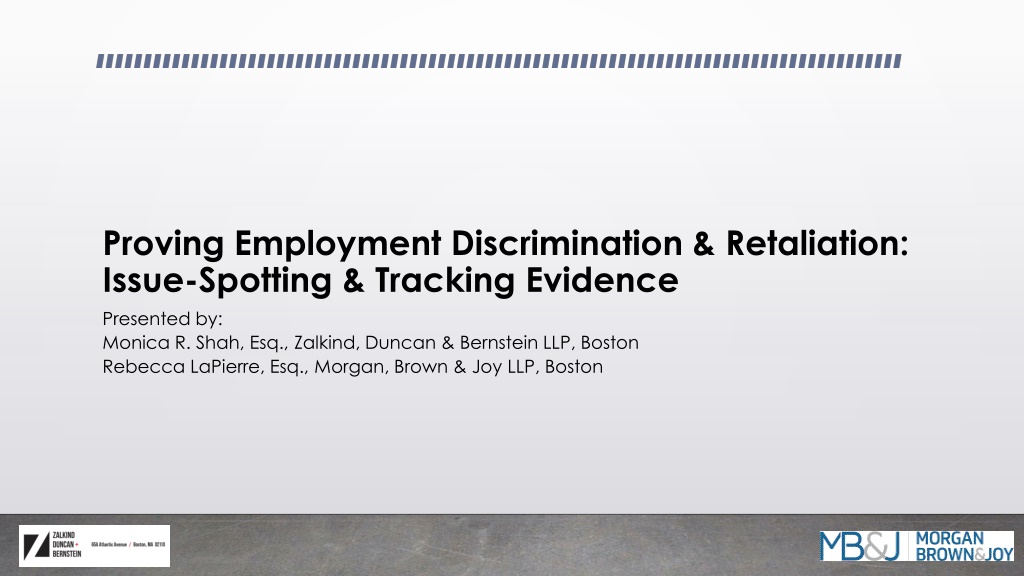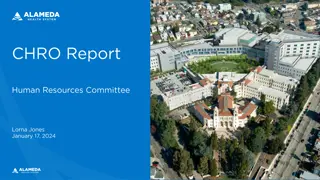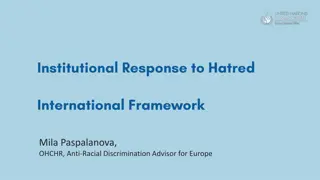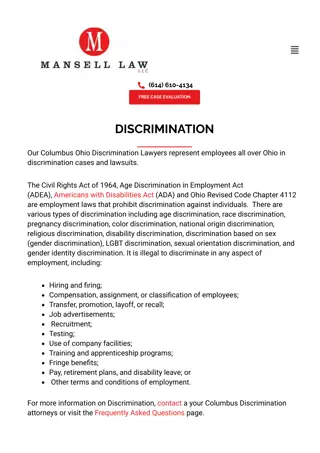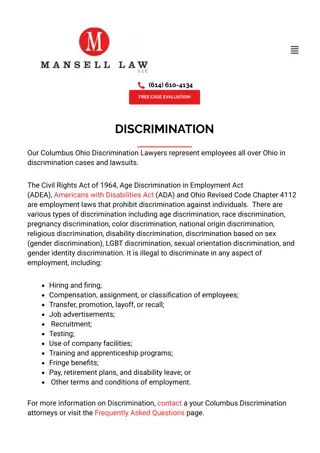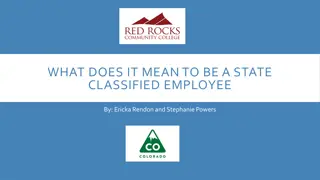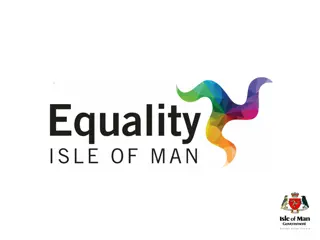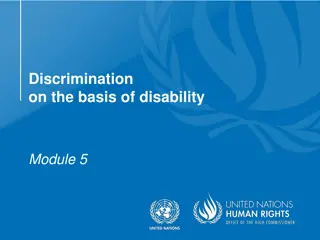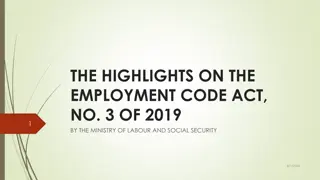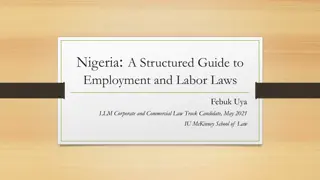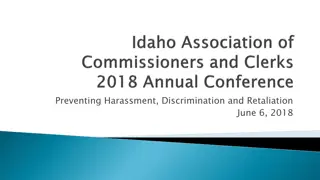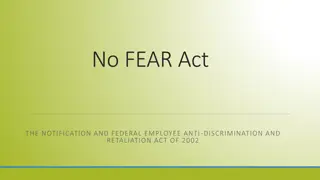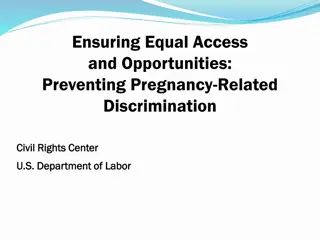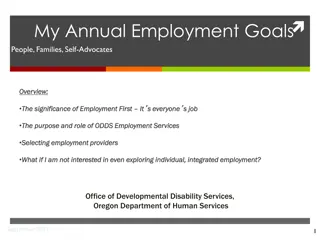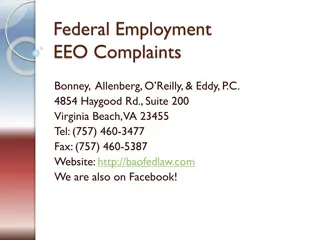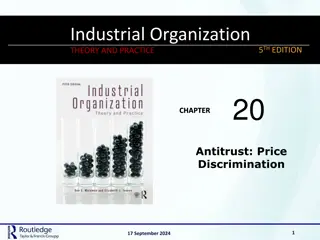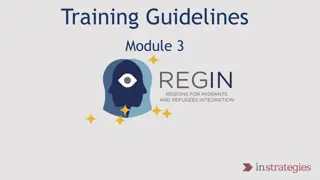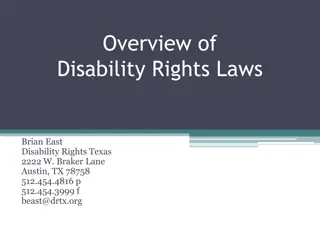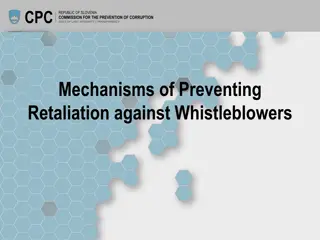Understanding Employment Discrimination and Retaliation Laws
This informative content delves into the nuances of employment discrimination and retaliation, outlining types of cases, stages of legal proceedings, protected classes under M.G.L. ch. 151B, elements of prima facie cases, and burden-shifting frameworks in proving discrimination or retaliation. It explores key concepts like hostile work environments, disparate treatment, disparate impact, and retaliation, providing valuable insights for legal practitioners and individuals navigating such issues.
Uploaded on Apr 02, 2024 | 2 Views
Download Presentation

Please find below an Image/Link to download the presentation.
The content on the website is provided AS IS for your information and personal use only. It may not be sold, licensed, or shared on other websites without obtaining consent from the author. Download presentation by click this link. If you encounter any issues during the download, it is possible that the publisher has removed the file from their server.
E N D
Presentation Transcript
Proving Employment Discrimination & Retaliation: Issue-Spotting & Tracking Evidence Presented by: Monica R. Shah, Esq., Zalkind, Duncan & Bernstein LLP, Boston Rebecca LaPierre, Esq., Morgan, Brown & Joy LLP, Boston
The Basics Types of cases Discrimination Hostile work environment coworker v. supervisory Retaliation Stages of the case: Intake/case evaluation Negotiations/mediation MCAD/EEOC complaint Court litigation SJ v. Trial (prima facie case versus ultimate question) Direct v. circumstantial evidence
M.G.L. ch. 151B Protected classes: Race, color, religious creed, national origin, sex, pregnancy status or related conditions, age (over 40 years old), sexual orientation, ancestry, genetic information, gender identity, handicap (disability), and military or veteran status. MCAD standard for finding of Probable Cause : If a fact-finder could form a reasonable belief that it is more probable than not that the respondent committed an unlawful practice. 804 Mass. Code Regs. 1.08(1)(f)(1). Elements of Prima Facie cases: Disability Discrimination: M.G.L. c. 151B, 4(16): Denial of a reasonable accommodation Employee is a qualified handicapped person under the statute, and capable of performing the essential functions of a job with a reasonable accommodation; employee made a request for an accommodation; employer refused the accommodation; employee suffered harm as a result of the refusal. Both the employer and the employee must approach the accommodation process in good faith. Discrimination on the basis of handicap Employee is handicapped within the meaning of the statute; Employee is qualified to perform the essential functions of the job with or without reasonable accommodation; Employee was terminated or otherwise subject to an adverse action by employer; and the employee s position remained open and the employer sought to fill it.
Elements of claims under MA law cont. Prima Facie case of Disparate Treatment Discrimination Employee is a member of a protected class protected by 151B; Qualified for job; Suffered an adverse employment action; Others outside the protected class were treated differently. Prima Facie case of Disparate Impact Discrimination: Employer utilized specific employment practices or selection criteria knowing that the practices or criteria were not reasonably related to job performance; and the Employer knew that the practices or criteria had a significant disparate impact on a protected class or group. Prima Facie case of Retaliation Employee Engaged in protected conduct; Suffered some adverse action; and A causal connection exists between the protected conduct and adverse action. McDonnell Douglas burden shifting framework: If Employee is able to satisfy all elements of the prima facie case, then the employer must articulate a legitimate, non-discriminatory reason for employment action; if the employer does so, the employee must show that the employer s defense is merely pretext for discrimination. Hostile Work Environment: A hostile work environment is one that is pervaded by harassment or abuse, with the resulting intimidation, humiliation, and stigmatization, [and that] poses a formidable barrier to the full participation of an individual in the workplace. Cuddyer v. Stop & Shop Supermarket Co., 434 Mass. 521, 532 (2001) (quoting College-Town, Inc. v. MCAD, 400 Mass. 156, 162 (1987)). The environment must be sufficiently hostile or abusive in light of all of the circumstances, including the frequency of the discriminatory conduct; its severity; whether it is physically threatening or humiliating, or a mere offensive utterance; and whether it unreasonably interferes with an employee s work performance. Thompson v. Coca-Cola Co., 522 F.3d 168, 180 (1st Cir. 2008) (quoting Faragher v. City of Boca Raton, 524 U.S. 775, 787-88 (1998)). Constructive Discharge [W]orking conditions were so difficult or unpleasant that a reasonable person in [the employee s] shoes would feel compelled to resign. See GTE Products Corp. v. Stewart, 421 Mass. 22, 34 (1995). The standard for establishing a constructive discharge is, and should be, a strict one. . . . (indeed) the mere act of discrimination, absent aggravating circumstances, is not sufficient to find constructive discharge. See Estate of McKinley v. Boston Harbor Hotel, 14 MDLR 1226, 1241 (1992).
Elements of a Discrimination Claim Title VII Disparate treatment prima facie elements: Membership in a protected class: Race; Color; National origin; Religion; Sex (including gender, pregnancy, sexual orientation, and gender identity); Qualified for the job; Adverse employment action; and Position unfilled or filled by comparably qualified person. Retaliation prima facie elements: Plaintiff engaged in a protected activity; Employer took a materially adverse employment action after the protected activity; Could dissuade a reasonable worker from making or supporting a charge of discrimination (Burlington Northern) The adverse action is causally connected to the protected activity (must be the but for cause of the employment action). McDonnell Douglas burden shifting framework applies for circumstantial evidence on SJ: Employer must articulate a legitimate, non-discriminatory reason for employment action; Plaintiff must show that the employer s defense is merely pretext for discrimination.
Age Discrimination under the ADEA Employee was at least 40 years old at the time of the discrimination; was qualified for the position; adverse action; and 4) the employer subsequently filled the position demonstrating a continued need for services. Subject to Mcdonnell Douglas burden shifting framework.
Pregnancy Accommodations under the Pregnancy Discrimination Act [A] plaintiff alleging that the denial of an accommodation constituted disparate treatment under the Pregnancy Discrimination Act's second clause may make out a prima facie case by showing, as in McDonnell Douglas, that she belongs to the protected class, that she sought accommodation, that the employer did not accommodate her, and that the employer did accommodate others similar in their ability or inability to work. Young v. United Parcel Serv., Inc., 575 U.S. 206, 229, 135 S. Ct. 1338, 1354, 191 L. Ed. 2d 279 (2015) [C]onsistent with the Act's basic objective, that reason normally cannot consist simply of a claim that it is more expensive or less convenient to add pregnant women to the category of those ( similar in their ability or inability to work ) whom the employer accommodates. Id. Employer may seek to justify its refusal to accommodate the plaintiff by relying on legitimate, nondiscriminatory reasons for denying her accommodation, which employee must show is pretextual.
Evidence of Pretext: What will raise an inference of discriminatory or retaliatory animus? There are many ways to demonstrate pretext. Here are just a few examples: Inconsistent/changing rationale for employment action; Similarly situated employees; Deviation from policies or practices; EEO-1/Demographic info composition of the employer s workforce; Statements made by decision makers; For retaliation, temporal proximity; Special issues: Federal versus state standard pretext plus v. pretext only Same actor inference hired/fired by the same person Stray remark doctrine
Common Affirmative Defenses in Employment Cases Failure to assert may waive the right to raise defenses later! Statute of limitations to file MCAD Charge 300 days from date of alleged discrimination (M.G.L. ch. 151B 5; 804 Mass. Code Regs. 1.04(3)) continuing discrimination any date after alleged discrimination begins up to and including the date it ended. No adverse employment action Doctrine of Unclean Hands Doctrine of Laches Reasonable Factor other than age After acquired evidence Same actor inference Statute of limitations for file with EEOC 180 days from the day the discrimination took place. Extended to 300 days if dually filed with MCAD Decision maker in same protected class Undue Hardship (failure to accommodate) Direct Threat (failure to accommodate) Failure to exhaust administrative remedies Workers Comp exclusivity Faragher-Ellerth Failure to mitigate damages Legitimate non-discriminatory reason for action Note this list is nonexhaustive. Employer not covered by applicable law Plaintiff s independent contractor status
Issue Spotting From Two Perspectives Management/Defense Employee/Plaintiff Who is Complainant/Plaintiff? Type of claims, nature of discrimination overt or more nuanced Current or former employee? Applicant? Investigate employment history Who is the plaintiff performance history, credentials, family, etc.? Asserted claims do the facts suggest there may be claims that are not indicated in the charge/complaint? Are there sufficient facts to establish a prima facie claim? Who is the employer type of industry, repeat offender/hostile climate, assets? Any facts that suggest pretext or support an inference of discrimination/retaliation? Affirmative defenses available Review employee s full history of employer practices, even past evidence could support claims Handbooks/policies and disciplinary history How are the policies actually applied in practice? Are violations/discipline documented? Do contemporaneous documents support plaintiff emails, personnel record, texts, etc.? Identify relevant employees: Who is accused of bad conduct? Identify other supporting witnesses and contact them (if permitted)? Are there any witnesses to alleged conduct? Individual liability/defendants Are there systemic issues that involve more than one employee? Supervisor/imputed liability Hiring manager, supervising manager, decision makers (if adverse action exists) Collect damages information lost wages and benefits, supporting evidence for emotional distress, and mitigation evidence Grains of truth: where did this charge stem from? Accuracy of dates/times Identify any weaknesses in case plaintiff or other witness credibility, weak performance, similar treatment of employees outside of protected class, etc. Needed for finding evidence (e.g. corrective action documents, CCTV footage, police reports, etc.) Creating a timeline particularly for retaliation claims
Issue Spotting: Sample EEOC Charge Form Does the latest date of alleged discrimination fall within the statute of limitations? Alleged basis of discrimination/protected classes identified here. Particular facts alleged are included here. Look for any facts that suggest other claims exist that are not identified above.
Collecting evidence: what and when? Employers: investigate the allegations ASAP upon receipt of Charge. Request necessary records early Your client may be slow to respond or have to jump through hoops to obtain certain records. If video footage is available, it may not be preserved for extended periods of time unless requested. Immediately request: Handbook/policies relating to conduct Personnel records/medical records Supervisor files relating to Complainant or allegations notes taken from meetings, handwritten records, etc. Emails, texts, any other written communications (internal messaging systems such as Teams) Collecting relevant personnel records and corrective action for accused bad actors or comparators Interview witnesses as soon as possible. Memories fade, employees leave, etc.
Collecting evidence: what and when? (ctd.) Employees: obtain and preserve evidence immediately Obtain client s personnel record immediately Create a chronology memories can fade especially given the timeline of cases Make sure backups of laptops and phones are made Get releases for relevant records - medical, psych, other employment records Talk to witnesses early and make sure you use an investigator or have a non- lawyer witness on the phone
Keeping track of witnesses Former employees Maintain last known contact information for all employees at separation. Key witnesses: collect a written statement before separation if possible. Consider how things ended: will this employee be cooperative? Does the employee hold a grudge against the company?
Proving or defending: MCAD/EEOC Charges Documentation/Requests for Information Performance evaluations CCTV/Security video footage Communications E-mail, text messages, internal chat systems, social media etc. Corrective Action records Employer Policies Personnel Files Employee Training Records Termination decisions Investigation Reports/Case Files Investigations into conduct Witnesses oral vs. written statements Former employees vs. current employees Credibility assessments Inconsistent statements Establish a Timeline Employer Handbook/Policies Employee Training Records Comparator information Similarly situated employees Age claims: who was hired to replace complainant? Demographics info Reasonable accommodation/Leave of absence records Be mindful of confidential information/medical records
Proving or Defending: Public Hearing After a probable cause determination either the parties or the MCAD may file a motion to complete discovery before the certification conference: Discovery may include: Interrogatories; Request for documents; Depositions; Subpoenas; Employment Site visits; Request for admissions (804 Mass. Code Regs. 1.10(2)). When to request a protective order limiting discovery MCAD is not bound by the rules of evidence observed by courts, except for the rules of privilege. MCAD may admit documents and records from a public agency investigation (i.e. investigation of the Charge), unless the source lacks trustworthiness and is unrelated to issues established in certification conference.
Proving or Defending: Summary Judgment or Trial Investigation and document discovery When to use interrogatories, requests to admit Which witnesses to depose versus getting affidavits from When to use 30(b)(6) depositions (see next slide) Preparing witnesses for trial Rules of evidence apply What records can be admitted? Know your hearsay exceptions.
30(b)(6) Depositions Testimony on behalf of the Business/Organization Plaintiff s 30(b)(6) deposition notice must describe with reasonable particularity the matters to be examined. Employer must designate the representative(s) who will testify on behalf of the company Testimony is binding Has a duty to educate the representative(s) on the matters subject to examination May need to review materials such as past depositions, exhibits, corporate records, employee files, etc. Representative(s) do not testify as to personal opinions or beliefs testimony must represent the company s position on the topics. Consider who should represent the company. Does the representative: appear credible, speak well, understand the business priorities and perspectives, has or is allowed access to privileged/confidential information, have existing knowledge of the case (and is that knowledge helpful or harmful), and has a good relationship with the company (is available and willing to testify).
Guidance on preservation requests and litigation holds What is a preservation request/litigation hold? Who should they be sent to? When should it be sent? What should be preserved? Consequences of failing to preserve? Strategic considerations Spoliation instruction if evidence is not preserved Retaliation if employer relays possible claims to witnesses under guise of preservation
Best practices for organizing evidence for use in discovery, summary judgment, and trial. Reviewing/organizing e-discovery Drafting and Responding to interrogatories and document requests Protecting privileged/confidential documents Determining what is responsive Objections to requests Witnesses: who to call and when? Charge/Hearing/Deposition/Trial Depositions Preparing for depositions; Defending a deposition; 30(b)(6) deposition; Using deposition transcripts to prepare SJ statement of facts Know which facts help or hurt your case don t get caught off guard When to get ahead of bad evidence Summary judgement proving or defending the existence of material questions of fact Expert Witnesses and Consulting Witnesses
Hypothetical Case Scenario Plaintiff is a female employee who reported to HR in June that she believed her supervisor was discriminating against women by diminishing them in meetings and having them do office chores in addition to their work. She has not received a promotion in her five years at the company, and expressed concern to HR that the company (with an all male executive team) had very few female managers. She was just given notice that she has been terminated and the reason initially given was that the company had to downsize, but she is the only person being laid off. Her personnel record contains a negative performance evaluation by her supervisor that was dated a week before she reported her HR concerns. Although the company is supposed to give annual performance reviews every June, it only does so sporadically and the evaluation in the personnel record was never signed by the Plaintiff. What are employer s counsel s next steps to evaluate the situation and protect their client? What are Plaintiff s counsel s next steps to evaluate the case?
Contact us: Monica R. Shah Rebecca LaPierre Morgan Brown & Joy 200 State Street, 11th Floor Boston, MA 02109 (617) 523-6666 rlapierre@morganbrown.com Zalkind Duncan & Bernstein LLP 65A Atlantic Avenue Boston, MA 02110 (617) 742-6020 mshah@zalkindlaw.com
